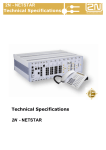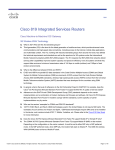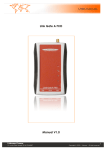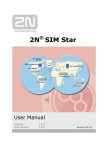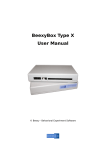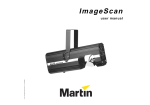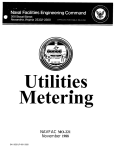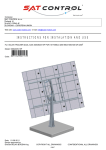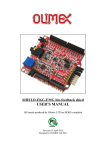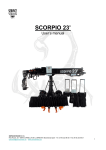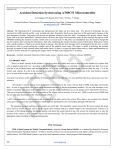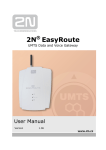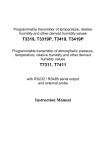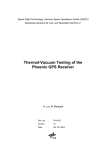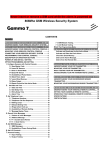Download 2N NetStar
Transcript
2N® NetStar Communication System Hardware manual Version 4.3.x www.2n.cz The 2N TELEKOMUNIKACE a.s. is a Czech manufacturer and supplier of telecommunications equipment. The product family developed by 2N TELEKOMUNIKACE a.s. includes GSM gateways, private branch exchanges (PBX), and door and lift communicators. 2N TELEKOMUNIKACE a.s. has been ranked among the Czech top companies for years and represented a symbol of stability and prosperity on the telecommunications market for almost two decades. At present, we export our products into over 120 countries worldwide and have exclusive distributors on all continents. 2N® is a registered trademark of 2N TELEKOMUNIKACE a.s. Any product and/or other names mentioned herein are registered trademarks and/or trademarks or brands protected by law. 2N TELEKOMUNIKACE a.s. administers the FAQ database to help you quickly find information and to answer your questions about 2N products and services. On www.faq.2n.cz you can find information regarding products adjustment and instructions for optimum use and procedures „What to do if...“. 2N TELEKOMUNIKACE a.s. hereby declares that the 2N® NetStar product complies with all basic requirements and other relevant provisions of the 1999/5/EC directive. For the full wording of the Declaration of Conformity see the CD-ROM (if enclosed) or our website at www.2n.cz. The 2N TELEKOMUNIKACE a.s. is the holder of the ISO 9001:2009 certificate. All development, production and distribution processes of the company are managed by this standard and guarantee a high quality, technical level and professional aspect of all our products. Content Content 1. System Installation . . . . . . . . . . . . . . . . . . . . . . . . . . . . . . . . . 4 1.1 Select of the Installation part . . . . . . . . . . . . . . . . . . . . . . . . . . . . . . . . . . . . . . . 6 1.2 Unwrapping and Control . . . . . . . . . . . . . . . . . . . . . . . . . . . . . . . . . . . . . . . . . . . 7 1.3 Installation . . . . . . . . . . . . . . . . . . . . . . . . . . . . . . . . . . . . . . . . . . . . . . . . . . . . . 8 1.4 Terms and Symbols . . . . . . . . . . . . . . . . . . . . . . . . . . . . . . . . . . . . . . . . . . . . . . 11 2. Technical specifications . . . . . . . . . . . . . . . . . . . . . . . . . . . . 12 2.1 Basic Module . . . . . . . . . . . . . . . . . . . . . . . . . . . . . . . . . . . . . . . . . . . . . . . . . . . 13 2.2 Extension Module . . . . . . . . . . . . . . . . . . . . . . . . . . . . . . . . . . . . . . . . . . . . . . . . 16 2.3 Position and Port Numbering . . . . . . . . . . . . . . . . . . . . . . . . . . . . . . . . . . . . . . . 17 2.4 CPU Card . . . . . . . . . . . . . . . . . . . . . . . . . . . . . . . . . . . . . . . . . . . . . . . . . . . . . . 18 2.5 CPU Card - Extension module . . . . . . . . . . . . . . . . . . . . . . . . . . . . . . . . . . . . . . 21 2.6 SWITCH card . . . . . . . . . . . . . . . . . . . . . . . . . . . . . . . . . . . . . . . . . . . . . . . . . . . 22 2.7 PRI Card . . . . . . . . . . . . . . . . . . . . . . . . . . . . . . . . . . . . . . . . . . . . . . . . . . . . . . . 26 2.8 BRI Card . . . . . . . . . . . . . . . . . . . . . . . . . . . . . . . . . . . . . . . . . . . . . . . . . . . . . . . 29 2.9 DVL Card . . . . . . . . . . . . . . . . . . . . . . . . . . . . . . . . . . . . . . . . . . . . . . . . . . . . . . 32 2.10 DIGITAL COMBO Card . . . . . . . . . . . . . . . . . . . . . . . . . . . . . . . . . . . . . . . . . . 34 2.11 4ASL/4AVL Card . . . . . . . . . . . . . . . . . . . . . . . . . . . . . . . . . . . . . . . . . . . . . . . 36 2.12 AVL Card . . . . . . . . . . . . . . . . . . . . . . . . . . . . . . . . . . . . . . . . . . . . . . . . . . . . . 38 2.13 GSM Card . . . . . . . . . . . . . . . . . . . . . . . . . . . . . . . . . . . . . . . . . . . . . . . . . . . . . 40 2.14 UMTS card . . . . . . . . . . . . . . . . . . . . . . . . . . . . . . . . . . . . . . . . . . . . . . . . . . . . 41 2.15 Audio Card_IO_Relay . . . . . . . . . . . . . . . . . . . . . . . . . . . . . . . . . . . . . . . . . . . . 42 2.16 IP Card . . . . . . . . . . . . . . . . . . . . . . . . . . . . . . . . . . . . . . . . . . . . . . . . . . . . . . . 46 3. Power source . . . . . . . . . . . . . . . . . . . . . . . . . . . . . . . . . . . . . . 47 3.1 Power Supply Connection . . . . . . . . . . . . . . . . . . . . . . . . . . . . . . . . . . . . . . . . . 48 3.2 System Grouping . . . . . . . . . . . . . . . . . . . . . . . . . . . . . . . . . . . . . . . . . . . . . . . . 49 3.3 Power supply backup . . . . . . . . . . . . . . . . . . . . . . . . . . . . . . . . . . . . . . . . . . . . . 51 4. Technical parameters . . . . . . . . . . . . . . . . . . . . . . . . . . . . . . . 55 1. System Installation Here is what you can find in this section: 1.1 1.2 1.3 1.4 Select of the Installation part Unwrapping and Control Installation Terms and Symbols Selection of the Installation Site The following aspects shall be taken into consideration while selecting a site for the system installation: Good accessibility: All interfaces for the connection of the telecommunication interfaces or data network connections, as well as the switch-on, switch-off and system reset controls are placed on the front side. Protection against humidity and extreme temperatures: The appliance may never be placed close to heat sources (radiators) or places exposed to direct sunshine. Also places with high humidity (such as bathrooms and cellars), places with significant temperature fluctuation (next to doors, windows, air-conditioning), dusty places (workshops, etc.) or places exposed to aggressive gases (accumulator room, boiler room) as well as places with intensive vibrations and places exposed to shocks (compressor rooms, heavy industrial operations) should be avoided. The system should be installed horizontally. Installation of infrastructure in the building: The system was designed for installation in a 19" rack and connection to the structured wiring infrastructure with termination at a CAT 3 or CAT 5 patch panel. If the infrastructure is already ready the switchboard installation site is usually given and can not be further changes. The interface must however be adjusted for the connection via RJ 45 8/8 plugs. 2N® TELEKOMUNIKACE a.s., www.2n.cz 4 GSM signal quality: If a GSM card is a part of your system (or will become later on), it is necessary to consider that the cable leading from the GSM card to the GSM antenna is usually 3m long (max. 10m). You should ensure that within this diameter from the selected system installation site a place with good GSM signal suitable for placement of the GSM antenna is available. *) Theft protection: While selecting the installation site the insurance company conditions should be regarded as well. Caution In the areas with very poor GSM signal level or high number of GSM gates the use of internal (takes the position of a line card) or external GSM splitter is advantageous. 2N® TELEKOMUNIKACE a.s., www.2n.cz 5 1.1 Select of the Installation part The following aspects shall be taken into consideration while selecting a site for the system installation: Good accessibility – All interfaces for the connection of the telecommunication interfaces or data network connections, as well as the switch-on, switch-off and system reset controls are placed on the front side. Protection against humidity and extreme temperatures – The appliance may never be placed close to heat sources (radiators) or places exposed to direct sunshine. Also places with high humidity (such as bathrooms and cellars), places with significant temperature fluctuation (next to doors, windows, air-conditioning), dusty places (workshops, etc.) or places exposed to aggressive gases (accumulator room, boiler room) as well as places with intensive vibrations and places exposed to shocks (compressor rooms, heavy industrial operations) should be avoided. The system should be installed horizontally. Installation of infrastructure in the building – The system was designed for installation in a 19" rack and connection to the structured wiring infrastructure with termination at a CAT 3 or CAT 5 patch panel. If the infrastructure is already ready the switchboard installation site is usually given and can not be further changes. The interface must however be adjusted for the connection via RJ 45 8/8 plugs. GSM signal quality – If a GSM card is a part of your system (or will become later on), it is necessary to consider that the cable leading from the GSM card to the GSM antenna is usually 3m long (max. 10m). You should ensure that within this diameter from the selected system installation site a place with good GSM signal suitable for placement of the GSM antenna is available. *) Theft protection – While selecting the installation site the insurance company conditions should be regarded as well. Note In the areas with very poor GSM signal level or high number of GSM gates the use of internal (takes the position of a line card) or external GSM splitter is advantageous. 2N® TELEKOMUNIKACE a.s., www.2n.cz 6 1.2 Unwrapping and Control Caution If you have not already done so, please check the completeness of the delivery. The wrapping of the basic or extension module is usually used also for the transportation of other, separately acquired system components (antennas and other small additional equipment). These can be checked by matching the items on the supply list and the ordering numbers stated on all components. Usually, the system is delivered as tailor made according to the submitted order. The installation set, electronic documentation on a CD and warranty certificate are a part of the delivery. The remaining components such as telephone units and other terminals or additional appliances are delivered separately. 2N® TELEKOMUNIKACE a.s., www.2n.cz 7 1.3 Installation Here is what you can find in this section: System Connection System Installation 2N® TELEKOMUNIKACE a.s., www.2n.cz 8 System Connection The system is installed into a RACK min. 400 mm deep. The height of each module is 3U - 132 mm. The system was not designed to be equipped with an active cooling unit, however the producer recommends in order to achieve a better air ventilation in case of bigger installations (more modules above each other) to leave a gap of e.g. 1U between the separate modules. For this purpose an organizer, which at the same time will ensure a better manipulation with the wiring, can be used. For a shelf installation the system is equipped with 4 stands that create a gap between the shelf and the module body to ensure sufficient system ventilation. 2N® TELEKOMUNIKACE a.s., www.2n.cz 9 System Installation The same applies for the connection to the 230 V or 115 V power supply Network, which is subject to the local and national regulations and directives. The connection of the system to the telecommunication network is subject to local national regulations and directives. The interface of the line cards terminates in a RJ45 plug. Only appliances complying with the basic requirements and further specifications of the directive no. 1999/5/ES (Government Directive No. 426/200 Coll., which stipulates the technical requirements of radio and telecommunication terminal appliances, in the wording of the later regulations) may be connected to the internal analogue interface. The supplied wiring including an additional connection to the single ground point is used for connection. If you do not use the additional system grounding, the over voltage protection integrated in the line cards will not work. The 2N® Netstar communication system was designed as digital appliance (TDM circle switching) with sufficiently powerful processor and LAN connection with integrated VoIP telephony. 2N® TELEKOMUNIKACE a.s., www.2n.cz 10 1.4 Terms and Symbols Manual Symbols The following symbols and pictograms are used in the manual: Safety Always abide by this information to prevent persons from injury. Warning Always abide by this information to prevent damage to the device. Caution Important information for system functionality. Tip Useful information for quick and efficient functionality. Note Routines or advice for efficient use of the device. Future Functions, Innovations The grey-marked text in this document designates the functions that are under preparation or development at present. 2N® TELEKOMUNIKACE a.s., www.2n.cz 11 2. Technical specifications Here is what you can find in this section: 2.1 Basic Module 2.2 Extension Module 2.3 Position and Port Numbering 2.4 CPU Card 2.5 CPU Card - Extension module 2.6 SWITCH card 2.7 PRI Card 2.8 BRI Card 2.9 DVL Card 2.10 DIGITAL COMBO Card 2.11 4ASL/4AVL Card 2.12 AVL Card 2.13 GSM Card 2.14 UMTS card 2.15 Audio Card_IO_Relay 2.16 IP Card 2N® TELEKOMUNIKACE a.s., www.2n.cz 12 2.1 Basic Module Here is what you can find in this section: Basic Module Basic Module Pro 2N® TELEKOMUNIKACE a.s., www.2n.cz 13 Basic Module The Basic Module Lite represents a business alternative of the basic module equipped with an CPU card, Switch X card that does not enable the connection of extension modules and one AVL card. Ord. no. 101034 2N NETSTAR BASIC rack basic module 8x AVL Ord. no. 101014 2N NETSTAR BASIC module 8x ASL 2N® TELEKOMUNIKACE a.s., www.2n.cz 14 Basic Module Pro Basic Module Profi is a business alternative of the basic module equipped with a CPU card, Switch card that enables the connection of up to 4 extension modules. Ord. no. 101031 2N NETSTAR PRO rack basic module (empty) Ord. no. 101011 2N NETSTAR PRO basic module (empty) 2N® TELEKOMUNIKACE a.s., www.2n.cz 15 2.2 Extension Module The extension module is equipped with an 8-bit CPU, which controls up to 11 analogue line cards. The following cards are supported: AVL, ASL, GSM and AUDIORELE. Ord. no. 101036 2N NETSTAR PRO rack extender analogue only Ord. no. 101016 2N NETSTAR PRO extender analogue only 2N® TELEKOMUNIKACE a.s., www.2n.cz 16 2.3 Position and Port Numbering Each card and port is assigned a specific unique HW address. The address consists of 4 parts and is stated in the form: R : C : B : P, whereas the separate letters stand for the following: R – rack Rack represents the entire system appliance consisting of the basic module and four extension modules (case), in the current version only one Rack is supported. The rack address is thus 0. C – case Covers the basic or one of the four extension modules. The address of the basic module is 1, the extension modules are assigned addresses from 2 to 5 according to their SWITCH card Connections. B – board The separate cards (board) are assigned addresses from left to the right, both in the basic as well as the extension modules. The address of the first position in the module is 1 and is reserved for maincase CPU or for extender CPU. Compared to the extension module, in which the cards are assigned addresses from 1 to 12, the assigning of addresses in the basic module is governed by predefined rules. The basic module uses following rules for the card positions and assigning of addresses. Address 1 Reserved for controlling CPU only (position 1) the card address is 0:1:1 Addresses 2,3,4 Reserved for the PRI and VoIP cards (positions 2,3 and 4) the cards addresses are 0:1:2, 0:1:3 and 0:1:4 Address 5 Reserved for the SWITCH card (position 5) the card address is 0:1:5 Addresses 6,7,8,9,10,11,12,13 and 14 The addresses correspond to the positions 6,7,8,9,10,11,12,13 and 14 and can be used for any line card. An exception are the positions with the addresses 6, 9 and 12, in which if you use a BRI or DIGITAL COMBO card the first 2 ports on the card are always NT and may not be changed. P – port The card ports are assigned the addresses from left to the right and from top to the bottom. The addresses start with 1. For the purpose of better orientation the PRI, GSM and Audio/IO/Relay cards have the serial numbers of the ports printed on their front side. 2N® TELEKOMUNIKACE a.s., www.2n.cz 17 2.4 CPU Card The card is an inseparable part of the basic module. It contains all necessary interfaces needed for the communication with the system. It is only installed in the basic module, always in the position with the 0 HW address. LAN 2N® TELEKOMUNIKACE a.s., www.2n.cz 18 Interface type – Eth T–Base 10/100 Connection – RJ45 Pin1= transit +, Pin2= transit -, Pin3= receive +, Pin6= receive - USB USB Host interface Connection Interface type – USB 1.1 Connection – 2x USB–A Physical layer – Low Speed – 1.5Mbits/s Power supply – 5V Consumption – max. 100mA COM RS 232C interface connection Interface type – RS232C Configuration – 115200Bd, 8bit, parity: none, stop bit: 1 Connection – RJ11 (6x6) Pin1= TxD-, Pin2= TxD+, Pin3,4= GND, Pin5= RxD+, Pin6= RxD- MMC MMC cards slot – MMC 7pins MMC 4.0 and MMC Plus 13 pins Buses – 1–bit (MMC) and 4–bit (MMC4.0 and MMC+) Power supply – 3,3V Reading speed – up to 22, Mb/s Writing speed – up to 18 Mb/s Maximum recommended capacity – 4 GB 2N® TELEKOMUNIKACE a.s., www.2n.cz 19 RES The Reset button will reboot the entire system. Maintenance switch ON position – appliance switched on OFF position – appliance switched off, the position is equipped with a 3s by-pass for the switching into the Maintenance Mode Maint. position – appliance in the maintenance mode, the line cards supply switched off and the card drivers stopped in order to enable their maintenance or exchange, or changes in the port set-up. After the switching into the ON position, the card drivers are launched and their power supply is switched on – no need for the re-launching of the entire system and starting of all processes. 2N® TELEKOMUNIKACE a.s., www.2n.cz 20 2.5 CPU Card - Extension module The card is an inseparable part of the extension module. Contains the proprietary interface for the communication with the SWITCH card. It is only installed in the extension module, always into the positions with the 0 HW address. The SWITCH board connection interface Interface type – proprietary Connection – RJ45 (8/8) Maximum connection length between SWITCH card and extension modul CPU card is 160 cm (wiring supplied as a part of the extender package) Total interface throughput between SWITCH card and extension module CPU card is available 31 channels (and 1 for signaling) total extension module throughput is 88 calls 2N® TELEKOMUNIKACE a.s., www.2n.cz 21 2.6 SWITCH card The SWITCH card is an inseparable part of the basic module. It can be supplied in two HW alternatives. Switch X without the possibility of extension modules connection, standardly supplied as a part of the Basic Module Lite version. Switch with the possibility of the connection of up to 4 extension modules. Both card versions are always equipped with 1 PRI interface and basic connection field that is in charge of the connection of call in the entire system. It is only used in the basic module and is always installed in the position with 5 as the HW address. The set-up of the Jumpers on the board determines the NT or TE port type NT port set-up For NT port the pins 1–3, 2–4, 5–7, 6–8 should be connected 2N® TELEKOMUNIKACE a.s., www.2n.cz 22 TE port set-up For TE port the pins 1–2, 3–4, 5–6, 7–8 should be connected. Extender connection interface Interface type – proprietary Connection – RJ45 (8x8) Maximum connection length – 160cm (wiring supplied as a part of the extender package) Total interface capacity – 124 calls Ratio capacity of the interface – 4x 31 calls Maximum capacity per 1 extender 88 calls 1x PRI interface Interface type – S0 without power supply / NT–TE Protocol – DSS1 – EURO ISDN 2N® TELEKOMUNIKACE a.s., www.2n.cz 23 Connection – RJ45 with LED control Pin1, Pin2 = broadcasting couple Pin4, Pin5 = reception couple LED control lamp RED – port not allowed by the licence NO LIGHT – port allowed by the licence, the line is not connected GREEN – communication interface connected to the 2nd layer Connection field Type – ZARLING Total capacity 512 channels Maximum number of simultaneous calls up to 172 – according to configuration 0,1,2,3 CPU Position 2 0 on PRI = 1 1 on PRI = 2 2 on PRI = 0 3 on PRI = 3 Position 3 0 on PRI = 2 1 on PRI = 0 2 on PRI = 1 3 on PRI = 3 Position 4 0 on PRI = 0 1 on PRI = 1 2 on PRI = 2 3 on PRI = 3 Switch 0,1,2,3 The card ports are marked blue, the Switch buses are marked red. The CPU card and the SWITCH card are filled 1:1. 2N® TELEKOMUNIKACE a.s., www.2n.cz 24 If more than 3 ports are occupied on the card or cards in the positions 2, 3 and 4, the PRI cards must be equipped with another ZARLING connection field. This ensures that the call channels of all ports are connected to the basic connection field of the SWITCH card. 2N® TELEKOMUNIKACE a.s., www.2n.cz 25 2.7 PRI Card The PRI card can be supplied in several HW configurations. The card can be configured to contain 1, 2 or 4 PRI ports, with or without included ZARLING connection field. If more than 3 PRI ports (the SWITCH card PRI port not including) are to be served by the system, the system needs to be equipped with the ZARLINK connection field cards. The factory pre-set of the ports is TE. Attention: the NS Admin programming tool uses these port settings during the HW activation. The card is installed into the position 1, 2 and 3 of the basic module, in between the CPU and SWITCH cards. The set-up of the Jumpers on the board determines the NT or TE port type NT port set-up For NT port the pins 1–3, 2–4, 5–7, 6–8 should be connected 2N® TELEKOMUNIKACE a.s., www.2n.cz 26 TE port set-up For TE port the pins 1–2, 3–4, 5–6, 7–8 should be connected 1 to 4 x PRI port Interface type – S0 without power supply / NT–TE Protocol – DSS1 – EURO ISDN Connection – RJ45 with LED control lamp TE modus Pin1, Pin2 = reception couple Pin4, Pin5 = broadcasting couple NT modus 1. Pin1, Pin2 = broadcasting couple 2. Pin4, Pin5 = reception couple 2N® TELEKOMUNIKACE a.s., www.2n.cz 27 LED control lamp RED – port not allowed by the licence NO LIGHT – port allowed by the licence, the line is not connected GREEN – communication interface connected to the 2nd layer 2N® TELEKOMUNIKACE a.s., www.2n.cz 28 2.8 BRI Card The BRI card services 8 fully functional BRI ports. The port configuration is TE or NT, with PTP or MPT line interface support. On the NT interface the power supply can be switched off – 42V. The factory settings of the ports are as follows: ports 0,2,4 and 6 preset as NT with power supply ports 1,3,5 and 7 preset as TE if you desire to use the BRI ports for the synchronisation, no line card position may be skipped between this card and the SWITCH card. The card is installed into the basic module on the line card position. Caution The NS Admin programming tool uses these port settings during the HW activation.. The set-up of the Jumpers on the board determines the NT or TE port type NT Pins 1–2, 3–4, 5–6, 7–8 and power supply pins to be connected 2N® TELEKOMUNIKACE a.s., www.2n.cz 29 NT without power supply Connect pins 1–2, 3–4, 5–6, 7–8 and do not connect the power supply pins TE Connect pins 1–3, 2–4, 5–7, 6–8 and do not connect the power supply pins Attention: On the positions with the HW addresses 5, 9 and 13 the ports 0 and 1 always have the NT configuration. 2N® TELEKOMUNIKACE a.s., www.2n.cz 30 8x BRI port Interface type – S0 (NT–S/T, LT–T) with phantom power supply – 42V S0 (TE–S/T, LT–S) without power supply *Protocol * – DSS1 – EURO ISDN Connection RJ45 TE modus Pin3, Pin6 = reception couple Pin4, Pin5 = broadcasting couple NT modus Pin3, Pin6 = broadcasting couple Pin4, Pin5 = reception couple Obj. no. 1011118 2N NETSTAR module 8x BRI 2N® TELEKOMUNIKACE a.s., www.2n.cz 31 2.9 DVL Card The DVL card contains 8 ports used for the connection of the Star Point digital telephone sets. the board always contains two sources of power per each four ports 0,1,2,3 a 4,5,6,7. If there occurs a short–circuit in the wiring (e.g. because of connection of an analogue phone), the power supply will be disconnected. After the technical deficiency was repaired, the power supply source will start to feed power into the ports again. The card is only installed into the position of the line card of the basic module. 2N® TELEKOMUNIKACE a.s., www.2n.cz 32 8x DVL port Interface type Upn (NT–U), LAP–S with power supply 48V Protocol Cornet II Connection RJ45 Pin4, Pin5 broadcasting/ reception Obj. no. 1011128 2N NETSTAR module 8x DVL 2N® TELEKOMUNIKACE a.s., www.2n.cz 33 2.10 DIGITAL COMBO Card The Digital Combo card consists of 4 BRI ports and 4 DVL ports used for the connection of the digital telephone sets. The specifications and characteristics of the ports match the specifications and characteristics of the card itself. If you desire to use the BRI port for synchronisation purposes, no line card position may be skipped between this card and the SWITCH card. The card is installed into the line card position of the basic module. The set-up of the Jumpers on the board determines the NT or TE port type NT Pins 1–2, 3–4, 5–6, 7–8 and power supply pins to be connected 2N® TELEKOMUNIKACE a.s., www.2n.cz 34 NT without power supply Connect pins 1–2, 3–4, 5–6, 7–8 and do not connect the power supply pins TE Connect pins 1–3, 2–4, 5–7, 6–8 and do not connect the power supply pins Caution On the positions with the HW addresses 5, 9 and 13 the ports 0 and 1 always have the NT configuration. 4x DVL port Interface type – Upn (NT–U), LAP–S with 48V power supply Protocol – Cornet II RJ45 Connection – two conductors, Pin4 and Pin5 = broadcasting/ reception 4x BRI port Interface type S0 (NT–S/T, LT–T ) with phantom power supply –42V S0 (TE–S/T, LT–S ) without power supply Protocol – DSS1 – EURO ISDN Connection – RJ45 – four conductors Pin3, Pin6 = broadcasting couple Pin4, Pin5 = reception couple Obj. no. 1011124 2N NETSTAR module 4x BRI/4x DVL 2N® TELEKOMUNIKACE a.s., www.2n.cz 35 2.11 4ASL/4AVL Card The card contains 4 ASL ports and 4 AVL ports. In case of power supply shortage the ASL ports are 1:1 switched to the AVL ports. We recommend to only connecting the telephone sets, which do not need additional power supply and are in compliance with the basic requirements and further respective provisions and stipulations of the 1999/5/ES Directive to the AVL ports. The card can be installed into any line position of the basic or the extension modules. 2N® TELEKOMUNIKACE a.s., www.2n.cz 36 4 x CO port Interface type – analogue with power supply –60V Signalisation – reverse polarity, CLIP broadcasting – FSK, DTMF Connection – RJ45 – two–wire Pin4, Pin5 = a/b wires Obj. no. 1011224 2N NETSTAR module 4xCO / 4x ASL 2N® TELEKOMUNIKACE a.s., www.2n.cz 37 2.12 AVL Card The card contains 8 AVL ports. Support of broadcasting of CLIP into the connected telephone sets via DTMF or FSK. Support of status signalisation, for pulse signalisation a constant polarity reverse is generated. The card is installed into any line position of the basic or the extension modules. Obj. no. 1011218 2N NETSTAR module 8x ASL 2N® TELEKOMUNIKACE a.s., www.2n.cz 38 8x ASL port Interface type – U analogue with power supply – 60V Signalisation – reverse polarity, CLIP broadcasting – FSK, DTMF Connection – RJ45 – two–wire Pin4 = GND, 0V Pin5 = –60V 2N® TELEKOMUNIKACE a.s., www.2n.cz 39 2.13 GSM Card The GSM card can be supplies in several HW configurations. Configuration with 1, 2 or 4 GSM ports (channels) The exchange of the SIM card in the GSM modules is only allowed if the card power supply is switched off, i.e. if the system is switched to the maintenance mode or completely switched off. An antenna must be connected to the SMA antenna connection; otherwise GSM module damage may occur. 1x SIM for 1 GSM module is supported The card is installed into any line position of the basic or the extension modules. GSM module Module type – SIEMENS TC35i, SIEMENS MC39 SIM SIM card type – SIM small 3V 2N® TELEKOMUNIKACE a.s., www.2n.cz 40 2.14 UMTS card The UMTS card can be supplies in several HW configurations. Configuration with 2 or 4 UMTS ports (channels) The UMTS card is equipped with antenna splitter. An antenna must be connected to the SMA antenna connection; otherwise UMTS module damage may occur. The exchange of the SIM card in the UMTS modules is only allowed if the card power supply is switched off, i.e. if the system is switched to the maintenance mode or completely switched off. 1x SIM for 1 UMTS module is supported The card is installed into any line position of the basic or the extension modules. UMTS module Module type – SIERRA WIRELESS MC8795V SIM SIM card type – SIM small 3V 2N® TELEKOMUNIKACE a.s., www.2n.cz 41 2.15 Audio Card_IO_Relay The card can be supplied in two HW configurations. The card configuration is 2x AUX and 4 x IO/Relay Or 4 x AUX and 8 x IO/Relay The card is installed into any line position of the basic or the extension modules. 4 or 8x IO–relay port Interface type – IO/relay Port function – according to chart Connection – removable WAGO connector, 8 pins 1port – consisting of a pin couple 2 or 4x AUX port Interface type – analogue Connection – Jack plug 3,5 mm stereo Pin0 (back ring) = GND Pin1 (middle ring) = Right channel Pin2 (front ring) = Left channel Input resistance: 160–380 kOhm (type 270kOhm) Input voltage range: max + -2,223V AC Output resistance: type 0.25Ohm Output voltage range: max + -2,223V AC 2N® TELEKOMUNIKACE a.s., www.2n.cz 42 2N® TELEKOMUNIKACE a.s., www.2n.cz 43 2N® TELEKOMUNIKACE a.s., www.2n.cz 44 2N® TELEKOMUNIKACE a.s., www.2n.cz 45 2.16 IP Card VoIP Card The VoIP card can be supplies in several HW configurations. 4, 8, 16, 24 or 32 voice channels. (IEEE 802.3) Ethernet 10/100 FullDuplex The card is installed into the position 1, 2 and 3 of the basic module, in between the CPU and SWITCH cards. 2N® TELEKOMUNIKACE a.s., www.2n.cz 46 3. Power source Safety These parts are connected with the power supply network and operate with a life dangerous voltage. Any repairs and exchanges of the parts may only be done by the producer!! Only the following maintenance works are permitted: • Safety fuse exchange • Connecting and disconnecting of the power supply cable Such maintenance works may only be executed while the system is not connected to the power supply network!!! Here is what you can find in this section: 3.1 Power Supply Connection 3.2 System Grouping 3.3 Power supply backup 2N® TELEKOMUNIKACE a.s., www.2n.cz 47 3.1 Power Supply Connection The detachable power supply cable is used for the connection to a regular power outlet. If necessary, the cable may easily be disconnected from the switch–board. In case of the switch–board installation outside the 19" rack the power supply cable may be conducted to a power outlet either freely or through a cable ledge. 2N® TELEKOMUNIKACE a.s., www.2n.cz 48 3.2 System Grouping Of course, the system is also grounded via the power supply network (thanks to the protective earth conductor – if this is connected to the outlet). However, such grounding is not considered sufficient – with regard to the danger resulting from the fact that the system may easily be disconnected from the power supply network (over-voltage stemming from any line may thus easily be spread to the system chassis and from there to any other line!). ATTENTION! The system should thus optimally be connected from the main switchboard through a yellow-green conductor with a diameter of not less than 4mm2 to the grounding ledge. In case of emergency the "earth" should be connected by such conductor (i.e. non-disconnectedly) to at least the closest power supply outlet (make sure that the outlet is connected correctly). The conductor should be attached to the system using the earthed connector (on the backside of the system panel, marked with the grounding symbol) that is to be fixed properly. The grounding should be connected prior to the connection of any other wiring!!! 2N® TELEKOMUNIKACE a.s., www.2n.cz 49 The grounding conductors are supplied with any package containing either basic or extension modules. The length of the conductor is for the basic and the extension unit 1500 mm. The ends of the conductor are equipped with a 4 mm diameter eyelet, one end of the basic module conductor has an 8 mm diameter eyelet. Grounding conductor of the extension unit Grounding conductor of the basic unit 2N® TELEKOMUNIKACE a.s., www.2n.cz 50 3.3 Power supply backup For the backup of the power supply in case of power shortage an on-line UPS appliance is used. The UPS is to be connected pursuant to the documentation supplied for the separate types and producers. The following chart will help you to design an optimal UPS performance. The values stated in the unconducting chart serve for information only, the consumption and the performance of the 2N® NetStar system change according to the current operational system load and the HW configuration of the separate modules. UPS – 800W / 1000VA Number of cases 1 2 3 4 5 Backup time 150 min 70 min 50 min - - UPS – 1600W / 2200VA Number of cases 1 2 3 4 5 Backup time 240 min 150 min 100 min 70 min 50 min NSVL8 , NSCOVL FXS – MINIMUM SERIAL RESISTOR <= 20 OHM Table 1: NSVL8 , NSCOVL – FXS 2N® TELEKOMUNIKACE a.s., www.2n.cz 51 COVL – 7320F3 SL PACKAGE Table 2: CO – FXO 2N® TELEKOMUNIKACE a.s., www.2n.cz 52 Table 3: COVL – FXO Itsp=max I 2N® TELEKOMUNIKACE a.s., www.2n.cz 53 2N® TELEKOMUNIKACE a.s., www.2n.cz 54 4. Technical parameters Basic technical specifications Nominal power supply network voltage: 230 V or 115V Power supply voltage tolerance: +/- 10 % Nominal frequency: 50 Hz Input: 160 Fuse: 10A Recommended power backup source: – External backup power source voltage: – Max. backup source consumption: – Typical operation time with fully charged batteries: – Basic unit size: 482x133x310 mm (84HPx3U) Basic unit weight: 12.5 kg Extended unit size: 482x133x310 mm (84HPx3U) Extended unit weight: 12.5 kg Communication interface LAN Signals: Pin1=transit +, Pin2=transit -, Pin3= receive +, Pin6= receive Transmission speed: 10/100 Mb/s Interface type: Eth T-Base 10/100 USB Signály: USB -A Transmission speed: 1,5 Mb/s Interface type: 2xUSB v1.1 R232 Signals: Pin1= TxD-, Pin2= TxD+, Pin3aPin4= GND, Pin5= RxD+, Pin6= RxDTransmission speed: 115200 Bd Interface type: RS 232C / 115200Bd,8bit ,parity=none, stop bit=1 2N® TELEKOMUNIKACE a.s., www.2n.cz 55 MMC Signals: MMC 7pins and MMC Plus 13 pins Transmission speed: up/down 18/22 Mb/s Interface type: 1-bit (MMC) and 4-bit bus Climate conditions Temperature range: +5...+45 °C. Relative air humidity: max. 85 % (40 °C) without condensation Premises description – basic characteristics: standard premises Operational position: horizontal Internal lines Analogue input impedance: 600 Ω Ringing voltage Line feeding voltage: 60V Line current: cca 25 mA External lines Analogue input impedance: 600 Ω SS voltage of closed loop at the I power =?? mA Maximum loop current: 65 mA SS resistance during pulse: min. 1 MΩ SS resistance during interruption: max. 320 Ω Earth-leakage power when hanged-up: max. 100 μA Ringing impedance: 2–10 kΩ Ringing voltage detection: 10–25 V Digital system lines Input power: 48V Call conduction impedance: 600 Ω Number of connectible conductors: 2 ISDN BRI ISDN BRI S0 TE: Interface type – S0 (TE–S/T, LT–S ) – for connection to VTS Protocol: DSS1 EURO ISDN with power supply Interface configuration: P–MP (point – several points) – supports MSN, P–P (point – point) – supports DDI Connection: 4-wires Connection type: RJ 45 2N® TELEKOMUNIKACE a.s., www.2n.cz 56 ISDN BRI S0 NT: Interface type – S0 (NT–S/T, LT–T) – inner S0 BUS Protocol: DSS1 EURO ISDN with power supply Interface configuration: P–MP (point – several points), P–P (point – point) Connection: 4-wires Connection type: RJ 45 ISDN PRI Typ rozhraní: S0 Protocol: DSS1 EURO ISDN Synchronisation: Master/Slave Connection: 4-wires Connection type: RJ 45 GSM Gateway Standard GSM900/1800, phase II Voice transmission: EFR, FR (enhacced full rate, full rate) Receiver sensitivity: -104 dBm Transmitter output: Up to 2W during pulse SMS support: TXT, PDU SIM card: small , 3V Antenna connection: SMA VoIP Specifications of the DTMF broadcasting selection: Minimum/ maximum level for the assessment of the lower or higher frequency: According to Q23 Specifications of the pulse selection broadcasting: Pulse duration: 60 ms Interruption duration: 40 ms Specifications of the pulse selection reception: Pulse duration: 30 ms to 70ms Interruption duration: 30 ms to 70ms FLASH detection FLASH broadcasting specifications: 100 ms FLASH reception specifications: 80 ms...150 ms (Preset values, can not be changed) 2N® TELEKOMUNIKACE a.s., www.2n.cz 57 FSK detection FSK reception specifications: 40 dB FSK broadcasting specifications: 40 dB Other signal detection Modem detection specifications: 1300 Hz Facsimile detection specifications: 1100 Hz Dial tone frequency: 425 Hz Dial tone level: -7 dB Busy tone frequency: 425 Hz Busy tone level: -7 dB Nominal transmission inhibition: Analogue – Analogue connection: -7 dB Analogue – Digital connection: -7 dB Digital – Digital connection: 0 dB Audio/IO/Rele The rights of the producer to adjust the product specifications in order to improve the characteristics of the product as compared to the product documentation are reserved. The product may only be used in compliance with the User's Manual and for purposes, for which the product was designed and manufactured. After the product lifetime was terminated please dispose the product or its parts in compliance with the valid environmental protection regulations. 2N® TELEKOMUNIKACE a.s., www.2n.cz 58 2N TELEKOMUNIKACE a.s. Modřanská 621, 143 01 Prague 4, Czech Republic Phone: +420 261 301 500, Fax: +420 261 301 599 E-mail: [email protected] Web: www.2n.cz xxx 2N® TELEKOMUNIKACE a.s., www.2n.cz 59



























































